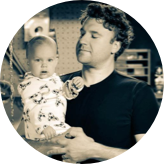“We’re pregnant!”
The overwhelming emotion that often follows this statement is familiar to many expecting parents. First comes the flood of joy, then follows the uncertainty about pregnancy. As a dad, your experience won’t be the same as the pregnant partner. You may often find yourself wondering what things dads should know about pregnancy. Indeed, you can’t carry the baby or experience morning sickness once in a while (the morning after twelve Hot Pockets doesn’t count). However, there are several things you can do to improve the experience, help your partner, and prepare for your baby.
Whether it’s your first child or second, it’s essential to stay ready and support your partner throughout the pregnancy. Preparation is key, which is why, in this post, we detail week by week pregnancy for dads. We focus on all trimesters to help you understand pregnancy as it slowly develops into your baby. While we understand that your experience is unique, we believe that our experiences are more similar than different. At the end of this pregnancy guide for men, we hope you’ll be informed, reassured, and rejuvenated for the pregnancy.
First Trimester

One of the first things dads should know about pregnancy is how to count the duration. If you missed out on Greek and Latin roots in school, the prefix tri– means three! The most common way to break down the trimesters of pregnancy is through weeks and months. Generally speaking, a pregnancy lasts nine months with the first trimester being ~13 weeks (although some people count the first 12 weeks), the second trimester being ~14 weeks, and the third being ~12 weeks. The first trimester starts on the first day of your partner’s last period and goes until the end of the thirteenth week. Within the first trimester, the baby and the mother change significantly. Let’s continue explaining the development during the first trimester.
Weeks 1 and 2
By the time your partner suspects a pregnancy and informs you, there’s a high chance that the first and second weeks have passed. The truth is that doctors cannot be sure. Sounds a little puzzling? Let’s explain.
Usually, conception occurs anywhere during the first and second week. However, health care providers include the beginning of your last period in the pregnancy window. Yes – even if your partner had their period, the doctors include it when counting the 40 weeks of pregnancy.
An ovum (egg) must be released into the fallopian tube for pregnancy to occur, where sperm should then fertilize the egg. However, cycles vary, so there’s no fixed date for ovum release. Note: it is possible to track the cycle to increase chances of fertilization.
Let’s take an example of a person with a 28-day cycle. This means that every 28 days, they have their period. Then, approximately 14 days after their period begins, or 14 days into their cycle, they ovulate. Ultimately, this is the best period to try for a baby because your partner is fertile.
What Can You Do?
During this period, keep calm and keep trying for the baby. As you continue to try for the baby, make sure you’ve tackled a few things.
- Preconception checkup
You may not be pregnant yet, but prenatal care begins long before fertilization occurs. A discussion with your gynecologist, together with your partner, is an excellent way to tackle any health issues. During the preconception checkup, your obstetrician-gynecologist (OB-GYN) asks questions about birth control, menstrual cycles, chronic conditions, medication, and diet.
At the end of the consultation, you and your partner find ways to boost fertility, increase the chances of pregnancy, and prepare a safe environment for fertilization to occur. It’s all about the information, and you should take in as much as you can.
- Take care of yourself and your partner
Use this time to improve your physical, emotional, and mental health. At this point, you’re trying ‘to-be-a-dad-to-be’, but you also need to be a loving and supportive partner. Enjoy sex, cuddle, talk, enjoy healthy food, and go on dates. Of course, make sure you’re on the same page about your pregnancy and child to come.
- Insurance and Financial Planning
If you’re trying for a baby, there’s a chance your insurance coverage isn’t top of your mind. Unfortunately, financial troubles are a quick way to strain through a pregnancy. We advise that you check on your insurance coverage before pregnancy.
Fortunately, most health insurance providers cover prenatal and maternity costs. If you’re a company employee, there’s a chance that your health insurance covers maternity costs. You can also research health insurance covers for your growing family at this point and plan for future out-of-pocket expenses.
Extend your financial planning to other expenses. Besides the prenatal care and insurance costs, you also have to care for a baby. Even if you don’t get down into all the details, it’s a great idea to have an amount in mind. You’ll likely find yourself exploring funds, insurance, savings plans, and business- and let’s be honest… some extra cash ain’t never hurt nobody.
Week 3
By the third week, your partner’s body is a flurry of activity. Remember the egg released during ovulation? It travels to a part called the fallopian tube. It sits and awaits fertilization. When sperm reaches the ovum and fertilizes it, a zygote forms, and once this happens, we can officially say that there’s pregnancy.
Your partner may not experience any noticeable physical or emotional changes. However, the zygote quickly divides to form multiple cells. This multiplying cluster of cells is called a blastocyst, and it may be microscopic at this point, but it creates critical cells to form the embryo and the placenta. The blastocyst will start to slowly move towards your partner’s uterus.
What Can You Do?
Once you complete the third week, you’re officially one month pregnant! The pregnancy calendar counts three weeks as a month of pregnancy. As the dad-to-be, make sure you continue to be supportive and caring.
Week 4
If you’ve gotten this far into the week by week pregnancy for dads, you’re already doing great. In the fourth week, the blastocyst arrives in the uterus and begins a process called implantation. After attaching to the uterine wall, this blastocyst grows over the next months to form your baby. Most people suspect pregnancy when implantation occurs.
Even if your partner isn’t peeing on pregnancy tests at home, they may notice a missing period, which is a good reason to suspect pregnancy. In addition, many people experience implantation bleeding. The bleeding usually occurs when the blastocyst burrows into the uterine wall. The bleeding is not severe and is significantly lighter than a period.
Our pregnancy guide for men would be incomplete without mentioning hormones. Hormones play a vital role in the development of your baby. Here are several hormones that play a vital role during this period.
- Human Chorionic gonadotrophin (hCG) is a hormone that is produced 6 to 12 days after fertilization, which typically falls in Week 4 or 5. This hormone is formed in the placenta and increases as the pregnancy progresses. Usually, when you and your partner go for testing, the doctors measure the amount of this hormone available in the blood. hCG is also the hormone picked up by pregnancy kits because it’s also present in urine.
- Estrogen levels also increase. Usually, estrogen helps the body adjust for pregnancy. It affects development in the uterus, breasts, and cervix.
- Progesterone: The level of progesterone is usually higher than estrogen. It encourages implantation in the uterus and prevents contractions in the uterus that cause pregnancy loss.
Week 5
In this week, the hormones increase rapidly as the body prepares for the development of the baby. The earlier mentioned hCG rises quickly and sends a signal to the ovaries to stop releasing another egg for fertilization and instead release estrogen and progesterone to help with the baby’s growth. Due to a hormone shift, your partner misses their period.
You can also discover pregnancy in the fifth week of pregnancy. It’s no cause for alarm. However, suppose your partner experiences pregnancy symptoms discussed in Week 4 and tests positive on a pregnancy test. In that case, it’s best to go to the hospital to confirm pregnancy through a blood test. Pregnancy tests at the hospital are safe and fast. They verify your pregnancy and help your OB-GYN confirm that everything is functioning as it should.
Inside the uterus, a baby, known as an embryo, is growing rapidly. The embryo divides into three layers and forms the foundation for the outer skin, the nervous systems, the inner eyes, and the ears. The middle cells give rise to the circulatory system, bone, ligaments, kidneys, and reproductive system. Lastly, we have the innermost layer, which develops into the lungs and intestines.
What Can You Do?
It may be a lot of science to remember, but don’t stress yourself into cramming every bit of it. What matters is that your baby is developing well. Once you confirm that you’re pregnant, there are several things you can do to make the pregnancy easier and safer.
- If you’re on laundry duty, wash it with unscented cleaners, especially if your partner complains about strong scents. Use unscented soaps, cut down on perfume, and avoid anything that triggers their nausea until the morning sickness goes away.
- Encourage your partner to consume meals high in iron, calcium, and vitamin C. You can also get them supplements such as folic acid with guidance from your doctor. Prepare nutritious meals that provide adequate nourishment for your partner and the developing baby. Make sure you include a healthy amount of protein, carbohydrates, and vitamins in each meal.
- If your partner is experiencing nausea and vomiting, help them replenish their electrolytes by giving them liquids. Broths, diluted juices, and hot water with lemon can soothe them.
As soon as you and your partner suspect pregnancy, schedule a visit with your OB-GYN. Your prenatal appointments are crucial for your doctor to investigate your medical history (if they haven’t already done so) and deal with any health conditions that may affect your pregnancy’s health. If you have your first prenatal appointment during this week, you can expect the following questions:
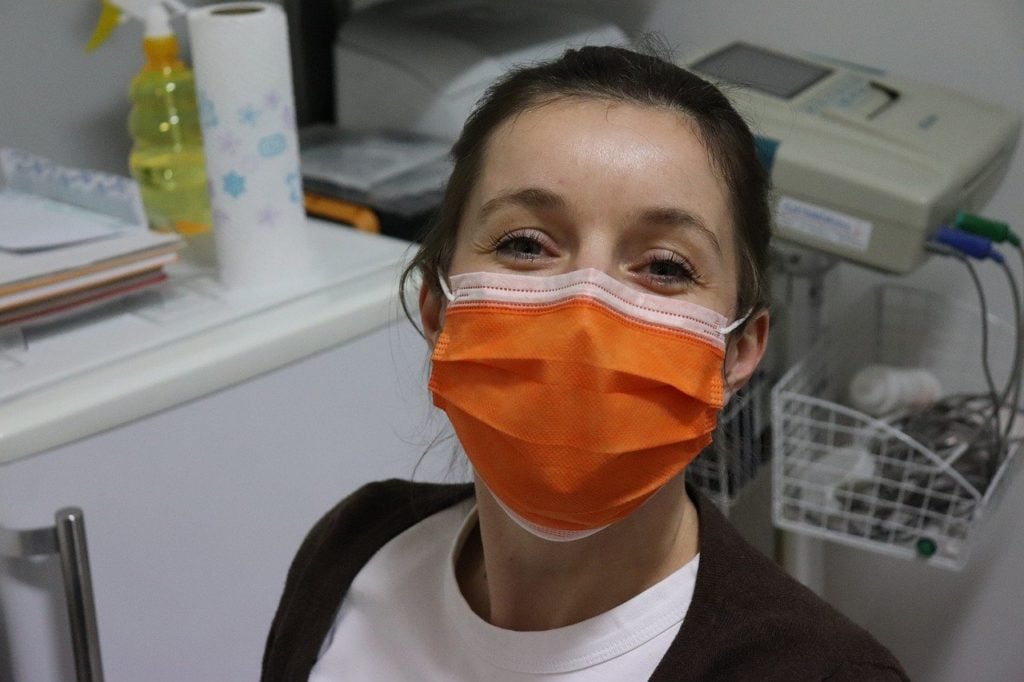
- Your partner’s menstrual cycle, birth control, medical history, and past pregnancies (if any)
- You and your partner’s medical and family histories
- Medication used recently
- Lifestyle habits such as smoking, alcohol consumption, and substance abuse
- Travel details, especially to areas with malaria, Zika virus, tuberculosis, among other infectious diseases.
- The physician also checks your partner’s body weight, blood, pressure, and height. If they feel that your partner isn’t in tip-top shape for the pregnancy, they’ll make recommendations for you and your partner.
- The doctor also checks for vital issues such as the Rhesus factor, hemoglobin levels, and immunity and explores infections such as HIV and sexually transmitted infections that affect the baby’s health and development.
Your Baby’s Growth After Week 5
At this point, you will probably be aware that your partner is pregnant. Let’s quickly run through what your baby will go through in the first trimester, shall we?
Week 6
In the first eight weeks of the pregnancy, the baby is called an embryo. In the sixth week of development, the embryo begins to form a curved tadpole-like shape. It also develops the neural tube from which the spinal cord and the brain develop. Also, foundational structures for the eyes, ears, and arms grow. It’s also in this stage that the heart develops, and you start hearing heartbeats! Exciting!
Week 7
The embryo’s head and face grow significantly in the seventh week. The depressions that form the ears become visible, and the retinas start forming. New buds that eventually form the legs rise, and the buds forming the upper limbs develop into pads.
Week 8
In the eighth week of development, the lower limb buds grow into paddles while fingers form on the upper limbs. The head also undergoes significant changes. Shapes of the ears and eyes become prominent, and the upper lip begins to form. The neck also starts straightening out.
Week 9
In the ninth week, you can now call your baby a fetus. In this stage of growth, the baby forms elbows and toes. Their eyelids also become visible. You’ll also notice a larger head and better neck formation.
Week 10
In the tenth week of growth, your baby’s head grows rounder, and the fingers and toes become less webbed and spread apart. Your baby can also bend their elbows at this point.
Week 11
By the eleventh week, your baby’s head grows broader, and the eyes separate. Other significant developments on the head include low-set ears and fused eyelids. The baby also grows buds that become future teeth. Inside the baby’s body, the red blood cells form the liver. At the end of the week, the baby’s genitalia also starts to grow.
Week 12
In week 12, the baby has intestines. Their facial features continue to develop, and they grow fingernails. Crazy, right?
Week 13
Up until this point, your baby’s head was the most significant part of the body. However, the rest of the body catches up. The kidneys and the urinary tract are functional, which allows the child to excrete amniotic fluid.
Meanwhile, What’s Happening to Your Partner in the First Trimester?
- As the baby develops, your partner experiences more physical pregnancy changes. First, the breasts become swollen, tender, and sore as they adapt to the hormonal changes.
- Nausea and vomiting become common as the body adjusts to the hormones. The best way to fight this is to eat in small portions, drink plenty of fluids, and consume fluids with ginger. It’s also best to avoid fatty foods and any foods that cause nausea.
- Your partner experiences more urination because the amount of blood increases. The kidneys work more frequently to clean blood.
- As hormone levels rise, your partner tends to experience more fatigue. Plenty of rest, nutritious goods, and exercise are helpful.
- Pregnancy hormones cause the relaxation of the valve between the stomach and esophagus, which causes heartburn. It’s crucial to avoid spicy meals, chocolate, and fried foods to prevent heartburn
- High levels of progesterone may cause slow movement of food, which causes constipation.
- Emotionally, your partner may experience mood swings. They may feel anxious, thrilled, and exhausted at the same time.
What Can You Do?

- Start your research!
- Now that your partner is approaching the second trimester, it’s time to start preparing for your new baby. We’ve got some great free checklists to get you pointed in the right direction, grab those right over here. Or, if you’re ready to jump in head first, consider an online course for expecting dads, we highlight 13 of the best ones out there here, and you can also check out Fathercraft’s own Father’s Ed—we’re biased, obviously, but we think it’s the most comprehensive and fun of the bunch.
- Let your partner get adequate sleep and rest. Take up more chores around the house and ask the rest of the family members to chip in. Also, drive your partner for hospital checkups as much as you can.
- Prepare healthy meals for the expectant mother. Include plenty of fluids and fiber in the diet to fight constipation. Try and avoid spicy, fried foods, citrus fruits, and chocolate to prevent heartburn.
- Help your partner prepare healthy meals they’re craving, and avoid those that cause nausea. Even if you can’t cook, you can help out with grocery shopping.
- Be supportive if your partner experiences mood swings you find challenging to understand. Talk to them, listen, and offer compassion.
- Visit the OB-GYN with your partner to discuss the pregnancy and educate yourself on things dads should know about pregnancy. Remember to ask as many questions as you can about week by week pregnancy for dads to help you feel less anxious or uncertain about the baby on the way.
- Attend all first trimester tests and screening. The series of prenatal tests help determine the health of your baby. In the first trimester, your doctor may recommend testing your partner’s blood and performing ultrasounds.
First Trimester Prenatal Screening
Your doctor can check for genetic abnormalities before your child is fully developed. Some of the genetic disorders that can be detected include cystic fibrosis, hemophilia A, Down syndrome, sickle cell disease, and polycystic kidney disease. It’s best to consult your OB-GYN on possible congenital disabilities.
Your doctor will recommend ultrasounds (nuchal translucency) to check for:
- Increased fluid in the fetal neck
- Growth of the nasal bone. Sometimes, this bone is not detectable in babies with Down’s syndrome. If any of the results from the ultrasounds are concerning, your doctor will recommend you and your partner for genetic counseling.
- The due date
- Ectopic pregnancies
- The number of fetuses in the uterus
Your doctor may also order maternal blood tests in the first trimester to check pregnancy-associated plasma protein-A and human chorionic gonadotropin (HCG) levels. Abnormally high levels indicate a problem. The healthcare provider will also test the blood for the risk of carrying a baby with Down syndrome.
What Are The Risks In Early Pregnancy?
Unfortunately, while we all look forward to a great pregnancy, sometimes things do not go as expected. Early pregnancy loss or miscarriage sometimes occurs in the first trimester. Pregnancy loss mostly presents as cramping and bleeding. As an expectant parent, it’s essential to be aware of the risks in the first weeks of pregnancy. As we’ve said before, it’s better to be informed than not.
There are several reasons why a pregnancy loss may occur:
- First is an abnormal number of chromosomes. You see, when an ovum and a sperm meet, they share chromosomes. Each contains 23 chromosomes, and together they form 46 chromosomes. These chromosomes then support the development of a healthy embryo. Without the correct number of chromosomes, growth does not occur properly.
- A miscarriage may occur due to strenuous physical activity or hormonal activity in the body.
- Lifestyle habits such as smoking and drinking also increase the risk of a miscarriage in the early pregnancy stages. It’s best to avoid smoking and drinking during pregnancy.
- Research indicates that the risk of a miscarriage increases with age. In this case, it’s crucial to stay in close communication with your OB-GYN.
- Even if your partner is bleeding and cramping, you can only confirm pregnancy loss with a checkup. Sometimes, the symptoms could be a sign of ectopic pregnancy. This is a condition where the implantation occurs in the fallopian tube instead of the uterus.
Second Trimester
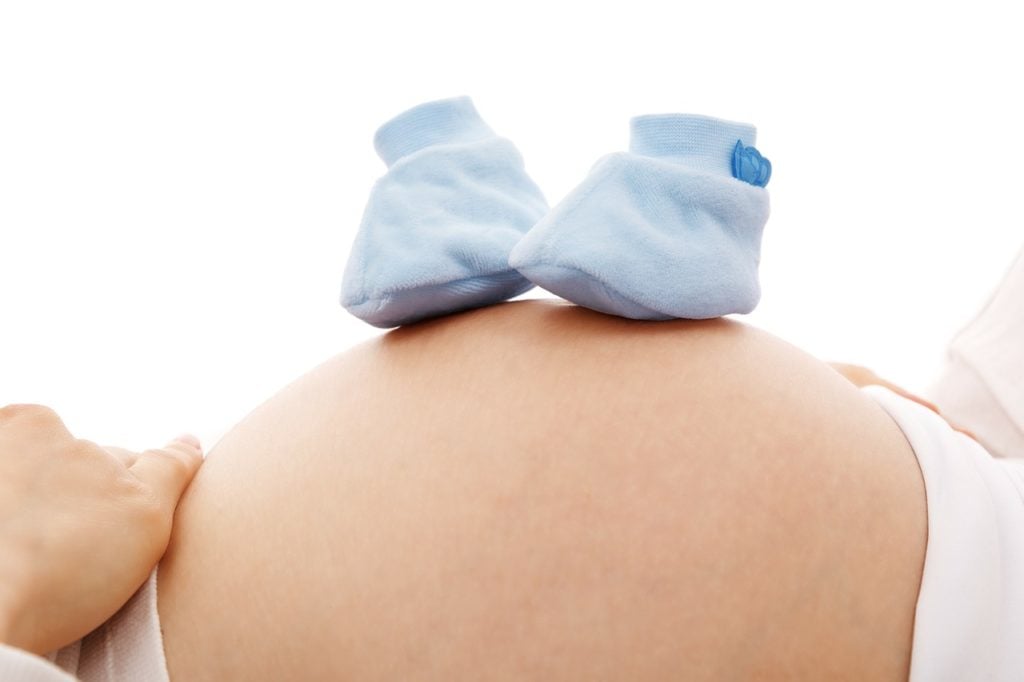
Congratulations on reaching the second trimester of your pregnancy! The second trimester of pregnancy is between week 14 and week 28. If you’re already in this part of the pregnancy, you can smile a little because, in most cases, the risks of early pregnancy are sufficiently over. Check out our first pregnancy guide for men for more details.
Your Baby’s Growth in Weeks 14-27
The second trimester of baby development is intense. By the end of this phase, the baby has functional systems. Your baby grows from around 3.5 inches and 1.5 ounces to 9 inches and 2 pounds. During the ultrasounds, you’ll see your tiny baby growing larger as they prepare to come to the world.
Week 14
The baby’s genitals develop, and their biological sex becomes more apparent. The baby’s spleen also begins to develop.
Week 15
The baby develops a scalp hair pattern. General bone development is intensifying at this point.
Week 16
The head becomes erect, and the baby starts moving its eyes. The ears also move to the correct position, and the skin thickens. You’ll also notice limb movement during ultrasounds.
Week 17
The baby’s activity increases, and they start rolling in the amniotic sac. They also develop toenails.
Week 18
Congratulations! Your baby can hear. The baby also faces forward and has a functional digestive system.
Week 19
In this week of growth, growth slows, and instead, the baby develops a protective coating called the vernix caseosa.
Week 20
At this point in the pregnancy, the baby sleeps and wakes. You may also feel the baby’s movements.
Week 21
Your baby has a fine layer of hair called lanugo which keeps the protective layer close to the skin. Your baby also develops the sucking reflex, which helps them suck on their thumb.
Week 22
In week 22, you can see the baby’s hair and eyebrows. Brown fat also begins to form in sites of heat production.
Week 23
The baby develops fingerprints, and the baby has rapid eye movement. Your baby can also hiccup at this point.
Week 24
Your baby’s skin begins to wrinkle and appears pink due to the blood capillaries on the skin.
Week 25
You baby can respond to your voice. However, the baby spends most of their time sleeping.
Week 26
The baby develops functional lungs.
Week 27
The baby’s nervous system and fat deposits continue to grow. This also marks the end of the second trimester.
Meanwhile, What’s Happening to Your Partner in the Second Trimester?
For most people, the second trimester is easier since the body adjusts to the changes. Nausea and fatigue decrease while more noticeable physical changes take shape. The baby bump also starts showing, and shopping for loose-fitting clothes becomes essential. Did someone say online shopping spree?
Your partner experiences the following changes:
- Body aches in the groin, back, and abdomen increase.
- Stretch marks begin to appear on the thighs, breasts, and stomach.
- A line running from the belly button to the pubic area arises.

- Your partner may experience numbing or tingling in the hands- this is called carpal tunnel syndrome. Fortunately, you can consult your doctor for treatment.
- Patches of dark skin may develop on the face, lips, and cheeks- this is called melasma or pregnancy mask.
- The ankles, toes, fingers, and face may swell.
- Irregular contractions in the abdomen may occur in the evenings, after physical exercise, or after sex.
- Nasal congestion may occur due to swelling of the mucous membranes. Saline drops can help relieve nasal congestion, and applying petroleum jelly around the nostrils can help with dryness.
- As a result of poor circulation, your partner may experience dizziness from time to time.
- The gums may also become more sensitive. It’s best to brush teeth with a soft brush and be careful around the gums.
- The risk of urinary tract infection (UTI) increases during pregnancy. It’s crucial for your partner to check for discomfort or pain during urination because it could indicate infection. Visiting the doctor is essential to treat UTI and prevent progression into the urinary tract and kidneys.
What Can You Do?
- Massage your partner’s back and pain points to help them with pain relief.
- Be reassuring and supportive of your partner’s physical changes.
- Help your partner consume more fluids or set up a humidifier for them to reduce nasal congestion.
- Maintain hygiene, especially in shared bathrooms, to reduce the risk of UTIs.
- Help your partner remain observant of the changes taking place. For instance, while weight gain and swelling are normal, sudden weight gain could indicate preeclampsia. If you and your partner are uncertain about something, schedule an appointment with your doctor.
- Attend doctor visits and second trimester testing with your partner.
- Do more research and read about pregnancy and newborn babies with your partner. We like The American Academy of Pediatrics’ Caring for Baby and Young Child, Birth to Age 5. And have we mentioned checklists can go a long way toward helping you feel prepared?
Second Trimester Prenatal Screening
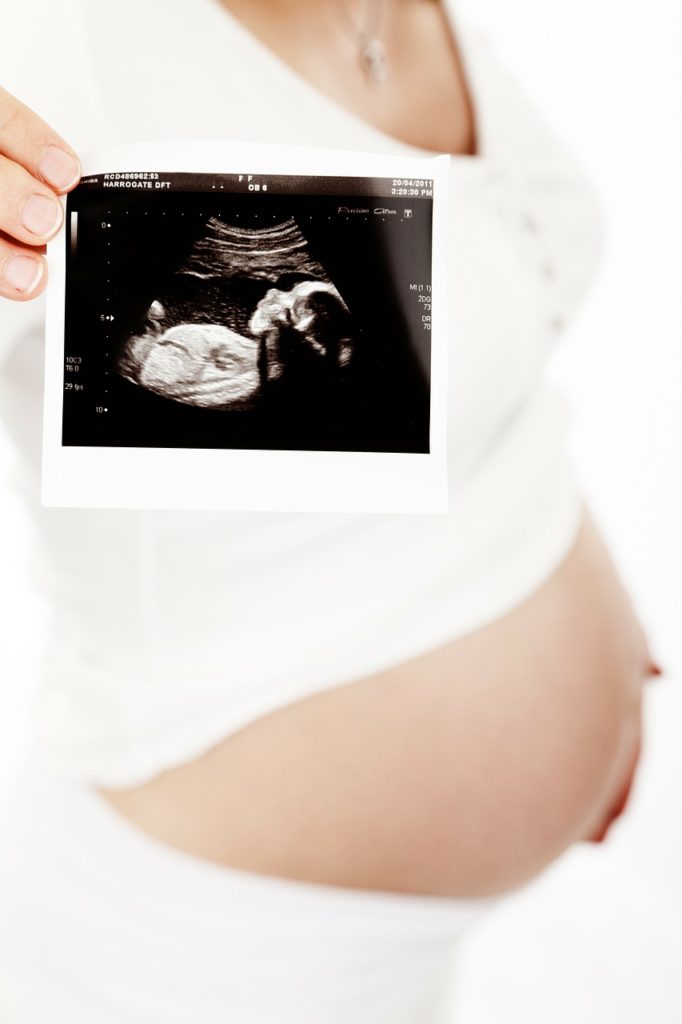
In the second trimester, your doctor may recommend tests known as multiple blood markers. These tests check for congenital disabilities.
- AFP screening checks for AFP levels in the blood. Abnormal levels may indicate abnormalities in the fetus’ abdominal walls, twins, Down’s syndrome, or spina bifida.
- Your doctor also checks for hormones such as hCG, estriol, and inhibin A in the placenta through blood tests.
- Your doctor may recommend amniocentesis between the 15th and 20th week of the pregnancy to confirm genetic defects and spina bifida.
- Your doctor may also perform routine ultrasounds to check on fetal development and prepare for advanced tests.
The end of the second trimester is a cause for celebration as you and your partner move into the third trimester. You can sing and talk to your baby because they can hear you and feel them as they move inside the uterus.
Third Trimester
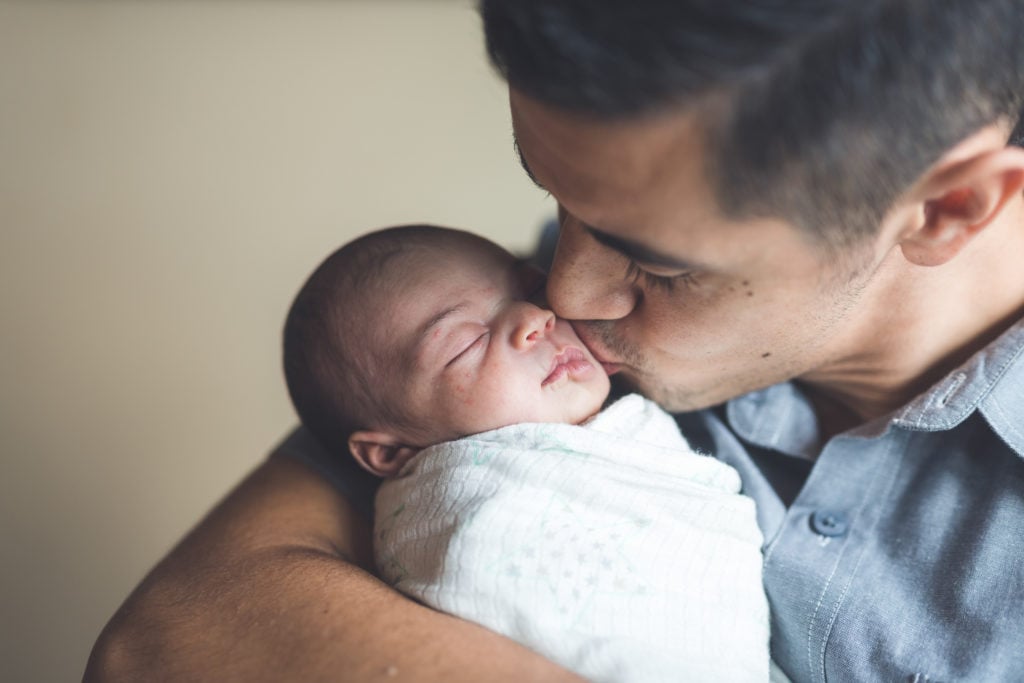
Getting to the third trimester of a pregnancy is a relief for many parents. By this stage, the baby has grown considerably and may even survive in an incubator if born pre-term. Your partner may generally feel more tired as their belly grows bigger day by day. Fortunately, the end is in sight in the third trimester, and you can start counting down week-by-week pregnancy to the birth of your child or children. Let’s explore the baby’s development in the third trimester.
Your Baby’s Growth in Weeks 28-40
This is the final stage in your baby’s growth during pregnancy. You’ve made it all this way, watching as your partner nourished your baby from a cluster of cells to a moving, breathing being that you can proudly call your child. They don’t call it the miracle of life for nothing, folks.
Week 28
The baby measures around 10 inches and weighs approximately 2.25 pounds by the beginning of the third trimester. At this stage of development, the baby can open their eyes, and their eyelashes are grown. Their central nervous system is also in full swing as it regulates body temperature and breathing movements.
Week 29
As the baby continues to grow, motion becomes more common. Your partner can feel the baby grasp, stretch and kick.
Week 30
The red blood cells inside your baby are busy forming the bone marrow. At this stage, your baby can open its eyes. The head is also healthily developed by this week.
Week 31
The baby begins to gain weight rapidly. The majority of the significant development is already complete by this week.
Week 32
Remember the soft layered skin called lanugo that formed around your baby? It starts to fall off this week. At this point, your baby measures around 11 inches and weighs about 3.75 pounds. Your baby also starts practicing breathing in preparation for birth.
Week 33
Your baby’s pupils begin to detect light and change in size in response to the stimuli. The bones in the body also harden, although the skull remains soft.
Week 34
The fingernails reach maximum development this week. The baby also grows in size and measures around 12 inches and 4.5 pounds by this week.
Week 35
The baby’s skin smoothens, and the limbs grow in chubbiness. Gotta love the chubbiness.
Week 36
The baby is large at this point and consumes most of the space inside the amniotic sac. You’ll notice lots of movement on your partner’s belly as the baby stretches.
Week 37
The baby’s head begins to turn down towards the pelvis in preparation for the birth. At this stage, the baby weighs approximately 6.5 pounds.
Week 39
In the 39th week, the baby’s chest is prominent. In males, the testes descend towards the scrotum. The baby also gains fat to keep them warm.
Week 40
Your baby may have a length of 14 inches from their crown to rump and weigh around 7.5 pounds. It’s during this week that the due date arrives and you have to go to the hospital. However, remember due dates may vary, and your baby may come anywhere during this period.
Meanwhile, What’s Happening to Your Partner in the Third Trimester?

In the third trimester, your partner may generally feel more tired because the baby gains significant weight. It can be physically and emotionally challenging to get through this period. Here are some of the changes you can expect in the third trimester:
- Braxton Hicks contractions: Your partner may experience mild contractions, especially in the evenings or after physical activity. The contractions grow in intensity as the due date approaches.
- Backaches: As the due date approaches, pregnancy hormones relax the connective tissue around the pelvic area in preparation for birth. Unfortunately, this causes discomfort and backaches. It’s best to wear comfortable flat shoes and avoid movement in this stage.
- Shortness of breath: Your partner may find themselves running out of breath frequently. Breathing exercises are recommended to keep the lungs strong.
- Heartburns: Pregnancy hormones tend to relax the valves between the stomach and the esophagus. This causes acid reflux, which is irritating.
- Prominent veins and hemorrhoids: Your partner may form spider veins along the face, neck, and arms. They may also develop painful varicose veins in their legs and get hemorrhoids in the rectal area. Soaking in warm tubs with witch-hazel helps with hemorrhoids.
- Increased urination: As the baby turns towards the pelvis, they place more pressure on the bladder, which causes frequent urination. Your partner may also have leaks when they sneeze, laugh or bend. Save the dad jokes for just a couple more weeks.
- The reality of birth, complications, and parenthood begins to set in. As such, your partner may be more anxious.
What Can You Do?
- As the pregnancy grows heavier and slightly uncomfortable, make your partner as physically comfortable as possible. Get them pillows and backrests to support their lower back.
- Avoid highly acidic meals, fried foods, citrus fruits, and spicy food to prevent heartburn.
- Help your partner elevate their legs and frequently exercise to reduce swelling in the legs. Draw warm baths for them to soak in and relax.
- Talk to your partner about the baby, birth, and plans for the child’s future. Make sure you’re on the same page to reduce stress.
Prenatal Care
As the due date approaches, your doctor will expect you and your partner to come in for more visits, especially after week 32. Your midwife may schedule you for visits every two weeks. Your healthcare provider will likely check for the following in your partner:
- Symptoms of discomfort
- Weight gain
- Blood pressure
- Preeclampsia: The doctor performs a urine test to find albumin, a protein that indicates preeclampsia.
- Hyperglycemia: The doctor checks the urine for glucose levels
- Top of the uterus
- Baby’s heartbeat
- Gestational diabetes: The doctor checks all symptoms that indicate the development of diabetes during pregnancy
- Group B strep: This bacteria develop in the vagina or rectum and may cause severe infection to the baby. The doctor recommends antibiotics if your partner has this bacteria.
- Anemia: during pregnancy, many people develop iron deficiency anemia. If your partner has anemia, they don’t have enough blood cells to circulate oxygen, making them tired.
- Your partner may also take an additional shot of vaccinations for diphtheria toxocoid and acellular pertuisis despite their vaccination status to prevent the unborn child from contracting whooping cough.
Birth- What To Expect

When the call finally comes in, or your partner breaks their water, it’s time to go to the hospital and deliver the baby. Hooray! The birth process is one of the crucial things dads should know about pregnancy- or rather the end of a pregnancy. In this stage, your biggest concerns are labor and delivery. How will the birth affect your baby and your partner? Let’s find out.
Labor
First, remember that labor is a natural process, which means it starts and proceeds at its own pace. However, doctors can intervene when necessary. Most women find that the amniotic sac breaks before labor and major contractions begin- this is called “water breaking.”
Take note of the color of the “water.” If it’s yellowish, then you and your partner are right on track. However, if the amniotic fluid looks greenish or red, call your doctor immediately and rush to the hospital. Just like the classic nursery rhyme: “If it’s yellowish, then we’re mellowish. If it’s red or green, GET YOUR ASS TO THE HOSPITAL!” Or something along those lines. Regardless, when the water breaks, call your midwife and drive to the hospital or get an ambulance.
During labor, the contractions cause the cervix to open and soften. These actions allow the baby to move into the vaginal canal. In the early stages of labor, the contractions are irregular. Your partner may also notice pinkish discharge, usually because of the mucus from the cervix. The early labor may last for a few hours or days.
This period is uncomfortable, but until the contractions increase in frequency, you and your partner have to wait it out. You can encourage your partner by helping them:
- Take showers and baths
- Go for slow walks
- Change positions
- Have relaxing conversations or listen to calming music
- Practice breathing exercises
After early labor, active labor begins. In this stage, the contractions are frequent and intense. The cervix dilates by 3-4 inches. Your partner may also feel:
- Pressure in their back
- Nausea
- Leg cramps
- Pain
Active labor may last up to eight hours. As the pain increases, you can help your partner by:
- Helping them roll on a birthing ball
- Practicing breathing exercises
- Taking warm showers
- Providing gentle massages
- Changing positions
- Taking walks
The final stages of active labor are excruciating and uncomfortable for your partner. Contractions come in around 60-second intervals. They may also feel like delivering the baby at this point.
Delivery
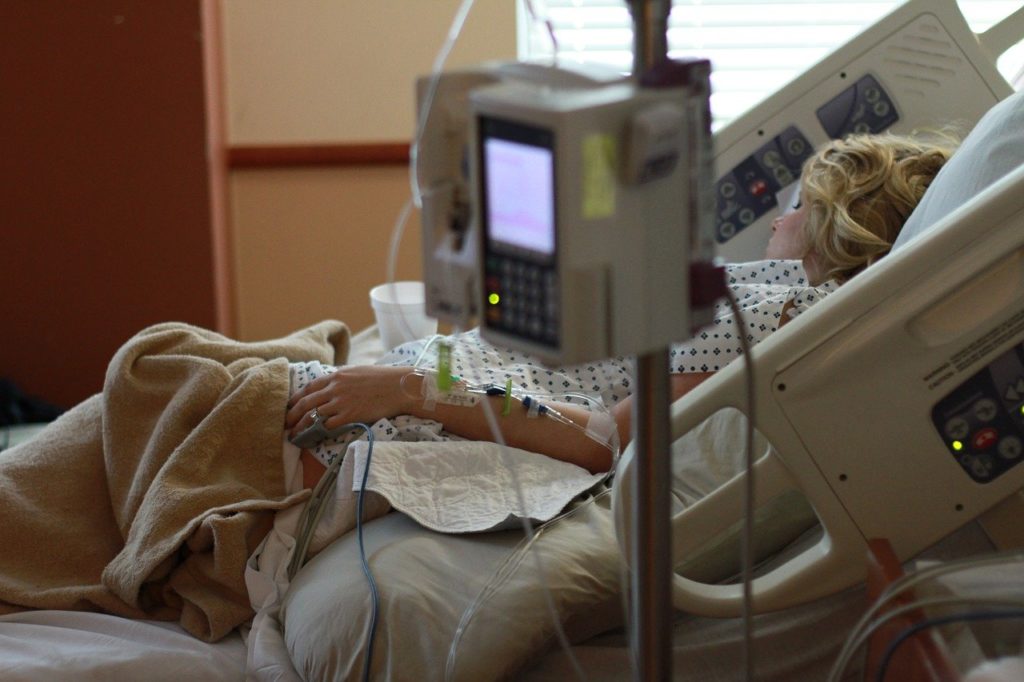
The birth of your baby could be a few minutes to several hours. It all varies depending on your partner and the baby. If you’re in the delivery room with your partner, the midwife will ask them to push the baby. It’s a challenging process and one that requires lots of encouragement and motivation from you. Your partner can push the baby out while lying down, squatting, kneeling, or standing.
Once the baby’s head is out, the rest of the body follows shortly. Sometimes, the doctor may recommend an episiotomy, a small cut on the perineum, to prevent injury during birth. The healthcare providers clear the airways and cut the umbilical cord as necessary. After the birth of the baby, the third part of labor and delivery begins. Your partner will experience mild contractions and has to push the placenta out.
The doctors may provide medication to minimize bleeding during the delivery process. After the placenta is out, contractions continue to return the uterus to its normal size. Your healthcare providers will also examine your partner to ensure that their body recovers. If stitches are necessary, the doctors will do them after the placenta is out.
Epidural
An epidural is a common method of pain relief. Many people request epidurals to help manage the pain that comes with labor. The epidural anesthesia relieves pain in a specific region without blocking total sensations. Before your due date, talk to your doctor or midwife about different epidural options.
Induced Labor
Usually, contractions should kick in after the water breaks. However, if contractions do not start after 24 hours, the doctor or midwife may have to induce labor. You’re probably wondering, “What is induced labor, and why does it matter?”
Labor induction is the use of medications to induce labor. There are several reasons why your doctor may induce labor:
- When the water has broken, but contractions have not started
- When it’s past the due date and contractions have not started
- When there isn’t enough amniotic fluid around your baby
- When the fetus stops growing at the expected rate
- When your partner has an infection in their uterus
- When the placenta separates from the uterus before delivery
- When your partner has medical conditions such as kidney disease, diabetes, or obesity
- Elective induction: You and your partner may choose to induce labor even when it’s not medically necessary. For this to happen, your baby should be at least 39 weeks old. This procedure may be available to people with rapid deliveries in the past and live far from health centers.
Are there risks of induced labor? Unfortunately, there are. Here are some of the risks you should know.
- Failed induction: The procedure may fail, which means that your partner may have to undergo a c-section to deliver the baby.
- Low heart rate: The medication used to induce labor causes rapid contractions that affect the baby’s heart rate and lower oxygen supply to the baby.
- Uterine rupture: if your partner has had a previous c-section or uterine surgery, inducing labor may cause rupturing.
- Bleeding: Induced labor increases the risk of severe bleeding after delivery.
- If your partner has had a c-section, undergone uterine surgery, or if the placenta is blocking the cervix, the doctor cannot induce labor.
- If the baby is lying sideways (traverse) or buttocks first (breech), your healthcare provider cannot induce labor.
C-Section
What if a natural birth does not happen? In some cases, your partner may have to deliver the baby through cesarian delivery or a c-section. This is a surgical procedure that takes the baby out from the abdomen or uterus. For first deliveries, a c-section may not be the obvious option until labor begins. However, if your partner has had a c-section before or develops complications with the pregnancy, your healthcare provider may plan for a c-section. There are several reasons why your doctor may recommend a c-section.
- If the labor stalls and the cervix fails to dilate
- If the baby is in an abnormal position. If the feet or buttocks are facing the cervix, the baby is in a breech position. If the baby is facing the cervix shoulder first, they’re in a transverse position.
- If your partner is carrying more than one baby
- If the placenta covers the opening of your cervix
- If a section of the umbilical cord comes out of the uterus before the baby
- If your partner has health conditions such as genital herpes or heart disease
- If your partner has pelvic fractures or fibroids covering the birth canal
What To Bring To Hospital
Before going to the hospital for childbirth, you have to carry essential items to the hospital. These items ensure that your partner and baby remain comfortable during their hospital stay. Here’s a checklist of what to pack for your child’s birth:
- Use a large duffel bag or backpack and separate your partner’s items and the baby things.
- Pack baby shawls, swaddles, hats, socks, diapers, burp cloths, baby bottles, pacifiers, and other newborn baby items
- A baby car seat
- Loose clothes that are easy to throw on
- Comfortable house slippers for you and your partner
- A yoga ball for labor
- Select a calming playlist or bring some essential oils for aromatherapy
- Hygiene products such as toothbrushes, toothpaste, pads, shower essentials, underwear, and deodorant
- Snacks and a water bottle
Stay Calm and Happy

Pregnancy is an exhilarating and challenging process for first-time and experienced parents alike. There is plenty to learn and experience during the nine months of pregnancy and after birth. Staying prepared by educating yourself is the best way to remain helpful as a father. Hopefully, our pregnancy guide for men will help you learn things dads should know about pregnancy. Remember to stay calm and positive and look forward to the baby.
Well, you made it! At least you made it to the end of this article. And you and your partner will make it through pregnancy too. And, educating yourself can go a long way toward helping you feel more prepared. That’s what we’re all about here at Fathercraft, learn more here.

